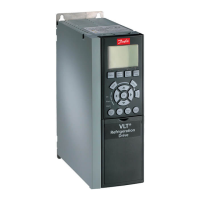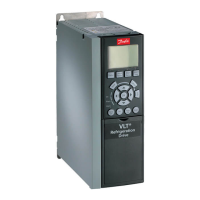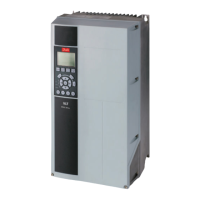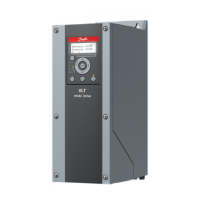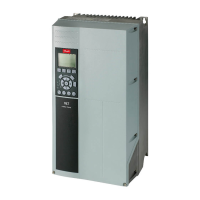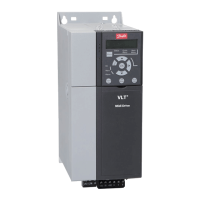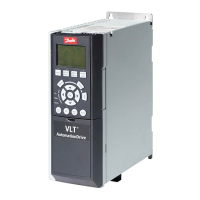1.
- a.
- b.
- c.
- d.
- e.
- f.
- g.
1.
2.
5.3.4.2 Programming Motor Data
After selecting [1] PM, Non-salient in parameter 1-10 Motor Construction , the PM motor-related parameters in parameter groups 1-2*
Motor Data, 1-3* Adv. Motor Data, and 1-4* Adv. Motor Data are active. The necessary data are on the motor nameplate and in the
motor data sheet. Program the following parameters in the listed order.
Procedure
Program in the following order:
Parameter 1-24 Motor Current.
Parameter 1-26 Motor Cont. Rated Torque.
Parameter 1-25 Motor Nominal Speed.
Parameter 1-39 Motor Poles.
Parameter 1-30 Stator Resistance
Enter line-to-common stator winding resistance (R
s
). If only line-line data is available, divide the line-line value
with 2 to achieve the line-to-common (starpoint value). It is also possible to measure the value with an ohmme-
ter, which takes the resistance of the cable into account. Divide the measured value by 2 and enter the result.
Parameter 1-37 d-axis Inductance (Ld).
Enter line-to-common direct axis inductance of the PM motor. If only line-line data is available, divide the line-
line value with 2 to achieve the line-to-common (starpoint) value. It is also possible to measure the value with an
inductancemeter, which takes the inductance of the cable into account. Divide the measeured value by 2 and
enter the result.
Parameter 1-40 Back EMF at 1000 RPM.
Enter line-line back EMF of the PM motor at 1000 RPM mechanical speed (RMS value). Back EMF is the voltage
generated by a PM motor when no drive is connected and the shaft is turned externally. Back EMF is normally
specified for nominal motor speed or for 1000 RPM measured between 2 lines. If the value is not available for a
motor speed of 1000 RPM, calculate the correct value as follows: If back EMF is, for example, 320 V at 1800 RPM, it
can be calculated at 1000 RPM as follows: Back EMF = (Voltage/RPM)x1000 = (320/1800)x1000 = 178. This is the
value that must be programmed for parameter 1-40 Back EMF at 1000 RPM.
5.3.4.3 Test Motor Operation
Procedure
Start the motor at low speed (100–200 RPM). If the motor does not turn, check installation, general programming, and mo-
tor data.
Check if the start function in parameter 1-70 PM Start Mode fits the application requirements.
5.3.4.4 Rotor Detection
This function is the recommended choice for applications where the motor starts from standstill, for example pumps or conveyors.
On some motors, an acoustic sound is heard when the impulse is sent out. This does not harm the motor.
5.3.4.5 Parking
This function is the recommended selection for applictions where the motor rotates at slow speed, for example windmilling in fan
applications. Parameter 2-06 Parking Current and parameter 2-07 Parking Time can be adjusted. Increase the factory setting of these
parameters for applications with high inertia.
Start the motor at nominal speed. If the application does not run well, check the VVC+ PM settings.
Table 18: Recommendations for Various Applications
Low inertia applications, I
Load
/I
Mo-
tor
<5
Increase parameter 1-17 Voltage Filter Time Const. by factor 5–10.
Reduce parameter 1-14 Damping Gain.
AQ267037536117en-000101 / 130R008344 | Danfoss A/S © 2023.09
Commissioning
VLT HVAC Drive FC 102
Operating Guide
